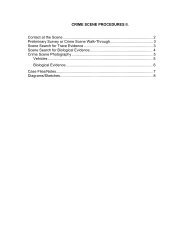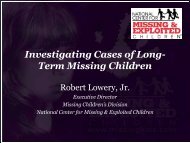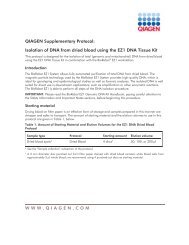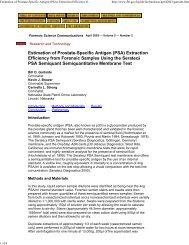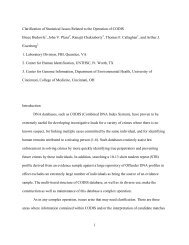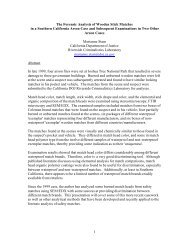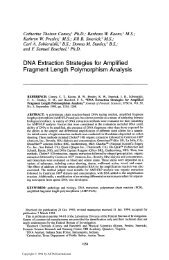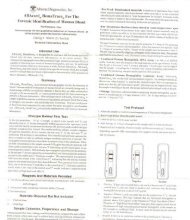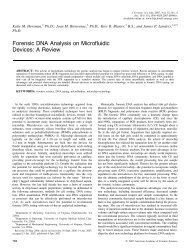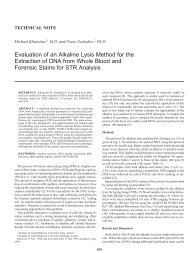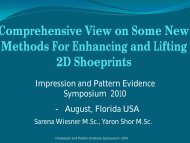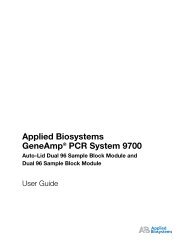Analysis and interpretation of short tandem repeat microvariants and ...
Analysis and interpretation of short tandem repeat microvariants and ...
Analysis and interpretation of short tandem repeat microvariants and ...
Create successful ePaper yourself
Turn your PDF publications into a flip-book with our unique Google optimized e-Paper software.
92 JOURNAL OF FORENSIC SCIENCESFIG. 4—Capillary electrophoresis <strong>of</strong> samples exhibiting ‘‘<strong>of</strong>f ladder’’ alleles: THO1 allelic ladder (panel 1), THO1 <strong>of</strong>f ladder allele (panel 2, openarrow ‘‘5’’); TPOX allelic ladder (panel 3), TPOX ‘‘<strong>of</strong>f ladder’’ allele (panel 4, arrow ‘‘13’’); CSF1PO allelic ladder (panel 5), CSF1PO <strong>of</strong>fladder allele (panel 6, arrow ‘‘10.x’’).between the canonical 10 <strong>and</strong> 11 alleles. The ‘‘10.x’’ allele was for CTT pr<strong>of</strong>iles for routine population databasing using the silverdesignated as a 309.4 basepair fragment using FMBIO 100 STaR- staining kit <strong>and</strong> SYBR ® Green I staining technique for allele detec-CALL2.0 s<strong>of</strong>tware that is two basepairs greater than the allelic tion. As a result, over 60,000 allele calls were recorded from whichladder 10 allele.42 samples (approximately 0.42%) were selected for further anal-There were also two THO1 <strong>microvariants</strong> detected during the ysis.course <strong>of</strong> this study (data not shown). One <strong>of</strong> the samples contained The existence <strong>and</strong> importance <strong>of</strong> repetitive sequences in eukaryaTHO1 ‘‘8.x’’ allele that migrated between the 8 <strong>and</strong> 9 nominal otic genomes has been known for decades (26–28). The extraordialleleswhen analyzed with all available detection systems. Analy- narily long t<strong>and</strong>em arrays stretching for greater than 100sis <strong>of</strong> this allele using GenoTyper2.0 <strong>and</strong> STaRCALL2.0 indicated megabases, such as those found in satellite DNA sequences, arethe allele was a single basepair less than the 9 allele, that is, an too cumbersome for clinical or forensic use. The minisatellite, or‘‘8.3’’ allele (data not shown). The other THO1 microvariant was variable number t<strong>and</strong>em <strong>repeat</strong> (VNTR) sequences have founddetermined to be a ‘‘10.x’’.considerable use in many scientific communities, including foren-Amplification <strong>of</strong> all ‘‘<strong>of</strong>f-ladder’’ <strong>microvariants</strong> with locus-spe- sics. In the past decade, microsatellite DNA, commonly referredcific primers confirmed not only that these alleles migrated outside to as <strong>short</strong> t<strong>and</strong>em <strong>repeat</strong> arrays or STRs, have been found to bethe default allele parameters, but also that the alleles were specific <strong>of</strong> significant importance for human identification (29). STRs arefor the locus to which their genotypes were assigned. As expected, highly variable in their <strong>repeat</strong> size length <strong>and</strong> are ubiquitous inall DNA samples in this study were identified as <strong>of</strong>f-ladder, three- the human genome. What has become evident from reports in theb<strong>and</strong>ed <strong>and</strong> were true single basepair difference genotypes or trueliterature is that there may be mutations at some STR loci that willhomozygotes by all allele detection systems.change the length <strong>of</strong> the t<strong>and</strong>em array by a single basepair or anDiscussionentire <strong>repeat</strong>. The molecular mechanisms involved in the dynamics<strong>of</strong> the polymorphic nature <strong>of</strong> STRs are thought to predominantlyMicrovariants at the CSF1PO, TPOX <strong>and</strong> THO1 loci are relarepairbe the result <strong>of</strong> replication slippage or defective DNA replicationtively rare in the Caucasian, Hispanic, <strong>and</strong> African-American populations.(30,31). This may explain, for example, that the CSF1PODNA extracts from over 10,000 individuals were analyzed ‘‘10.2’’ microvariant was originally an ‘‘11’’ <strong>repeat</strong> size in which




